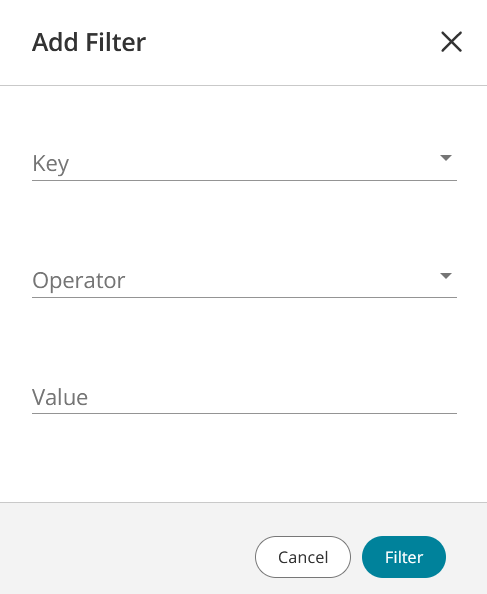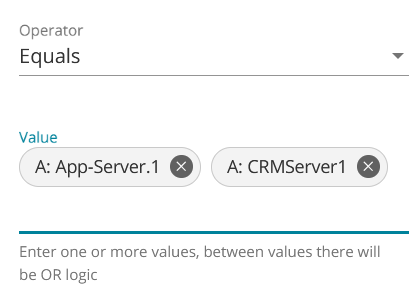On This Page
Navigating SecureCloud
The Navigation panel provides links to SecureCloud actions and functions.
Main Menu
The main menu appears in the left panel. Menu items with sub-menus include an arrow icon and, when selected, the sub-menu appears.
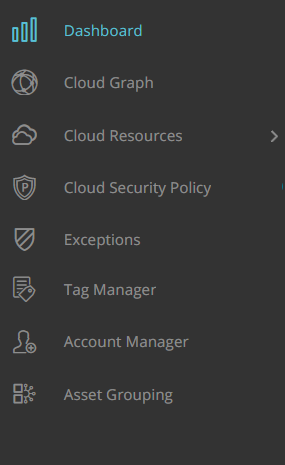
The full menu structure:
- Dashboard
- Cloud Graph
-
Cloud Resources
- Exceptions
- Cloud Security Policy
- Tag Manager
- Account Manager
- Asset Grouping
-
Configuration
Logging out
Click your user icon at the top of the page and then click Log out.
Getting Help
The ? help icon is displayed at the top of every page; click it to display the Help Menu. Options:
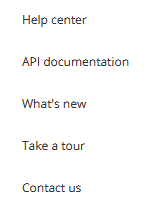
-
Help center: Takes you to the Knowledge Center topic that corresponds to your current SecureCloud page.
-
API documentation: Lists all SecureCloud API calls.
-
What's new: See the latest changes in SecureCloud.
-
Take a tour: A brief look at the main functions you need to get started with SecureCloud.
-
Contact us: Directs you to the Tufin customer portal.
Refreshing the Page
While you are working in the SecureCloud application, the data displayed on the page could become outdated due to external events such as network policy changes or actions of other SecureCloud users such as adding allowed connections. When moving from one page to another, the new page is always refreshed with the latest data. However, if you remain on the same page, these changes are not automatically reflected.
You can refresh the current page manually by clicking the Refresh icon ![]() at the top of the page at any time.
at the top of the page at any time.
Sorting Tables
Most tables can be sorted in ascending or descending order by one or more columns. Click on the column header of column to sort by the contents of that column. Click again to reverse the sort order.
Resizing Columns
Table column can be resized to make reading easier. Hover over a column divider in the header of a table, and drag the column separator bar right or left.
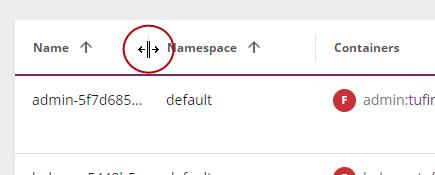
Filtering
The filtering options vary according to context:
General Filtering
Some pages can be filtered by various criteria, relevant to the content. Some filters always appear and cannot be removed. In some places, such as cloud graph and asset graph, filtered items appear in blue.
-
Click Add a filter

The Add Filter window appears:
-
Click Key and select the desired property from the list
-
Click Operator and select the desired operator from the list. The available operators will vary according to context.
-
Click Value and enter the value or select the value from the list
-
Some filter keys, such as tags and violations, can have multiple values. When more than one value is specified, the result is an OR relationship between the values. In this example, one of the filters must be true:
-
Click Filter to proceed
-
Repeat the steps above to add additional filters if required.

When more than one filter is specified, the result is an AND relationship between filters. In this example, both of the filter conditions must be true for an item to be included in the display.

-
Edit a filter by clicking on it.
-
Remove a filter by clicking X on the filter. Some filters are fixed and cannot be removed.
Filters are not retained when leaving the current page. However, you can save them by saving the full URL displayed when the filter is applied.
Filter Matrix
|
Key |
Description and Usage - Usage May Vary by Page |
Appears in Page |
|---|---|---|
| Account | Account name as defined in Account Manager. Select a single account from the list or enter text that appears in any account name. | Cloud Graph, Assets, Security Controls |
|
Application security groups (ASGs) |
ASG associated with the entities on the page. Select an ASG or enter text that appears in any ASG. |
Assets |
| Asset name | Asset name as defined in Assets. Select an asset or enter text that appears in any asset name. | Cloud Graph, Assets, Security Controls |
| Asset type | Asset type as defined in Assets. Select an asset type or enter text that appears in any asset type. | Cloud Graph, Assets, Security Controls |
|
Availability Zone |
Availability zone associated with the entities on the page. Select an availability zone or enter text that appears in any availability zone name. |
Assets |
| Has traffic | Traffic was detected on the asset. Currently supported for AWS and Azure. Nodes with traffic appear on any level in the Cloud Graph. | Cloud Graph, Assets |
| Internet exposed | Asset can be accessed from the Internet. | Cloud Graph, Assets |
| Load balancer name | Load balancer associated with the entities on the page. Select a load balancer or enter text that appears in any load balancer name. | Cloud Graph, Assets |
|
Network tags |
Network tag associated with the entities on the page. Select a network tag or enter text that appears in any network tag name. |
Assets |
|
Policy Coverage |
Indicates if the connection between two entities is covered by a policy. |
Cloud Graph, Assets |
| Region | Region associated with the entities on the page. Select a region or enter text that appears in any region name. | Cloud Graph, Assets |
|
Resource type |
Resource type associated with the entities on the page. Select a resource type or enter text that appears in any resource type name. |
Assets |
| Security control name | Security control associated with the entities on the page. Select a security control or enter text that appears in any security control name. | Cloud Graph, Assets. Security Controls |
| Security control type | Security control type associated with the entities on the page. Select a security control type or enter text that appears in any security control type. | Security Controls |
|
Service account |
Service account associated with the entities on the page. Select a service account or enter text that appears in any service account name. |
Assets |
|
Severity |
Severity associated with the entities on the page. Select one or more severities or enter text that appears in any severity. |
Assets |
|
Subnet |
Subnet associated with the entities on the page. Select a subnet or enter text that appears in any subnet. |
Cloud Graph, Assets |
|
Tags |
Tags associated with the entities on the page. Select a tag (Cloud Graph page) or single/multiple tags (Assets page) from the list or enter text that appears in any tag. |
Cloud Graph, Assets |
|
Vendor |
Vendor associated with the entities on the page. Select a vendor or enter text that appears in any vendor name. |
Cloud Graph, Assets, Security Controls |
|
Violating policy name |
Violating policies associated with the entities on the page. Select one or more violating policies. |
Cloud Graph, Assets, Security Controls |
|
Violations |
Violations associated with the entities on the page. Select one or more violation types. |
Cloud Graph, Assets, Security Controls |
|
Virtual Network |
Virtual network associated with the entities on the page. Select a virtual network. |
Cloud Graph, Assets |
Copy / Paste Fields
A number of pages display the copy-to-clipboard icon ![]() when hovering over a field to allow easy copy/paste of information.
when hovering over a field to allow easy copy/paste of information.
Clickable Items
Some fields such as assets and security controls can be clicked to drill down and display them in detail and some of these also have the option of right-click giving common browser link options such as opening in a new window or tab.
In the asset panel, which is displayed from a number of places e.g. Cloud Graph, you can click on ![]() to open the asset details in a new tab.
to open the asset details in a new tab.
Download as CSV File
Some pages, such as Permissive Access by Asset, have the option of exporting and downloading the information displayed as a CSV file, which can be viewed using Excel and other CSV readers. When available, the CSV icon ![]() appears.
appears.
Pin Window
On some pages, clicking a line or an element displays a window with additional details. In some cases, a pin icon appears on the window. Toggle the pin icon to switch between displaying the window while overlaying part of the original area (not pinned - ![]() ) and displaying it without overlaying the area (pinned -
) and displaying it without overlaying the area (pinned - ![]() ). When pinned, if other items are selected from the list, the window remains in place and its contents are updated with the appropriate information for the new selected item.
). When pinned, if other items are selected from the list, the window remains in place and its contents are updated with the appropriate information for the new selected item.
